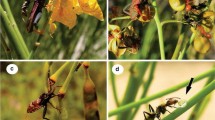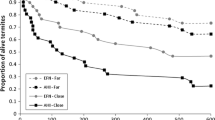Abstract
Plants in some 300 genera produce extrafloral nectar (EFN) to attract ants as a means of indirect defence. Among Mesoamerican Acacia species, obligate myrmecophytes produce EFN constitutively to nourish symbiotic ant mutualists, while non-myrmecophytes induce EFN secretion in response to herbivore damage to attract non-symbiotic ants. Since symbiotic Acacia ants entirely depend on the host-derived food rewards while non-symbiotic ants need to be attracted to EFN, this system allows comparative analyses of the function of EFN components in ant nutrition and attraction. We investigated sugar and amino acid (AA) composition in EFN of two myrmecophytes (Acacia cornigera and Acacia hindsii) and two related non-myrmecophyte species (Acacia farnesiana and Prosopis juliflora). AA composition allowed a grouping of myrmecophytes vs. non-myrmecophytes. Behavioural assays with obligate Acacia inhabitants (Pseudomyrmex ferrugineus) and non-symbiotic ants showed that AA composition affected ant preferences at high but not at low AA/sugar ratios. Most interestingly, behavioural responses differed between the two types of ants tested: Symbiotic ants showed a clear preference for higher AA concentrations and preferred nectar mimics with those four AAs that most significantly characterised the specific nectar of their Acacia host plant. In contrast, non-symbiotic ants distinguished among nectars containing different sugars and between solutions with and without AAs but neither among nectars with different AA/sugar ratios nor among mimics containing different numbers of AAs. Our results confirm that both AAs and sugars contribute to the taste and attractiveness of nectars and demonstrate that the responses of ants to specific nectar components depend on their life style. AAs are a chemical EFN component that likely can shape the structure of ant–plant mutualisms.





Similar content being viewed by others
References
Baker, H. G., and Baker, I. 1973. Amino acids in nectar and their evolutionary significance. Nature 241:543-545. doi:10.1038/241543b0.
Baker, H. G., and Baker, I. 1975. Studies of nectar-constitution and pollination–plant coevolution, pp. 100–140. in L. Gilbert and P. H. Raven (eds.). Animal and Plant Coevolution. University of Texas Press, Austin.
Baker, H. G., Opler, P. A., and Baker, I. 1978. A comparison of the amino acid complements of floral and extrafloral nectars. Bot. Gaz. 139:322-332. doi:10.1086/337008.
Bentley, B. L. 1977. Extrafloral nectaries and protection by pugnacious bodyguards. Ann. Rev. Ecol. Syst. 8:407-427. doi:10.1146/annurev.es.08.110177.002203.
Blüthgen, N., and Fiedler, K. 2004. Preferences for sugars and amino acids and their conditionality in a diverse nectar-feeding ant community. J. Anim. Ecol. 73:155–166. doi:10.1111/j.1365-2656.2004.00789.x.
Blüthgen, N., Gottsberger, G., and Fiedler, K. 2004. Sugar and amino acid composition of ant-attended nectar and honeydew sources from an Australian rainforest. Aust. Ecol. 29:418–429. doi:10.1111/j.1442-9993.2004.01380.x.
Carter, C., Shafir, S., Yehonatan, L., Palmer, R. G., and Thornburg, R. W. 2006. A novel role for proline in plant floral nectars. Naturwissenschaften 93:72–79. doi:10.1007/s00114-005-0062-1.
Chapman, R. F. 1983. The insects: structure and function. Harvard University Press, Cambridge, MA.
Clement, L. W., Köppen, S. C. W., Brand, W. A., and Heil, M. 2008 Strategies of a parasite of the ant-Acacia mutualism. Behav. Ecol. Sociobiol. 62:953-962. doi:10.1007/s00265-007-0520-1.
Dafni, H., and Kevan, P. G. 1994. A hypothesis on complementary amino acids in nectar. Evol. Theor. 10:259–260.
De La Fuente, M. A. S., and Marquis, R. J. 1999. The role of ant-tended extrafloral nectaries in the protection and benefit of a Neotropical rainforest tree. Oecologia 118:192–202. doi:10.1007/s004420050718.
Gardener, M. C., and Gillman, M. P. 2002. The taste of nectar—a neglected area of pollination ecology. Oikos 98:552–557. doi:10.1034/j.1600-0706.2002.980322.x.
Heil, M. 2007. Indirect defence—recent developments and open questions, pp. 360–395, in U. Lüttke, W. Beyschlag and J. Murata (eds.). Progress in Botany. Springer, Berlin.
Heil, M. 2008. Indirect defence via tritrophic interactions. New Phytol. 178:41–61. doi:10.1111/j.1469-8137.2007.02330.x.
Heil, M., and McKey, D. 2003. Protective ant–plant interactions as model systems in ecological and evolutionary research. Ann. Rev. Ecol. Evol. Syst. 34:425–453. doi:10.1146/annurev.ecolsys.34.011802.132410.
Heil, M., Fiala, B., Baumann, B., and Linsenmair, K. E. 2000. Temporal, spatial and biotic variations in extrafloral nectar secretion by Macaranga tanarius. Funct. Ecol. 14:749–757. doi:10.1046/j.1365-2435.2000.00480.x.
Heil, M., Koch, T., Hilpert, A., Fiala, B., Boland, W., and Linsenmair, K. E. 2001. Extrafloral nectar production of the ant-associated plant, Macaranga tanarius, is an induced, indirect, defensive response elicited by jasmonic acid. Proc. Natl. Acad. Sci. U.S.A. 98:1083–1088. doi:10.1073/pnas.031563398.
Heil, M., Greiner, S., Meimberg, H., Krüger, R., Noyer, J. L., Heubl, G., Linsenmair, K. E., and Boland, W. 2004. Evolutionary change from induced to constitutive expression of an indirect plant resistance. Nature 430:205–208. doi:10.1038/nature02703.
Heil, M., Rattke, J., and Boland, W. 2005. Post-secretory hydrolysis of nectar sucrose and specialization in ant/plant mutualism. Science 308:560–563. doi:10.1126/science.1107536.
Inouye, D. W., and Inouye, R. S. 1980. The Amino acids of extrafloral nectar from Helianthella-quinquenervis (Asteraceae). Am. J. Bot. 67:1394–1396. doi:10.2307/2442143.
Janzen, D. H., 1974. Swollen-thorn acacias of Central America. Smithsonian Institution Press, Washington DC.
Kautz, S., Lumbsch, H. T., Ward, P. S., and Heil, M. 2009. How to prevent cheating: a digestive specialization ties mutualistic plant–ants to their ant–plant partners. Evolution. 63(4):839–853.
Koptur, S. 1979. Facultative mutualism between weedy vetches bearing extrafloral nectaries and weedy ants in California. Am. J. Bot. 66:1016–1020. doi:10.2307/2442565.
Koptur, S. 1992. Extrafloral nectary-mediated interactions between insects and plants, pp. 81–129, in E. A. Bernays (ed.). Insect Plant Interactions. CRC Press, Boca Raton, Florida.
Lanza, J. 1988. Ant preferences for Passiflora nectar mimics that contain amino acids. Biotropica 20:341–344. doi:10.2307/2388328.
Lanza, J. 1991. Response of fire ants (Formicidae: Solenopsis invicta and S. geminate) to artificial nectars with amino acids. Ecol Entomol 16:203–210. doi:10.1111/j.1365-2311.1991.tb00210.x.
Lanza, J., and Krauss, B. R. 1984. Detection of amino acids in artificial nectars by two tropical ants, Leptothorax and Monomorium. Oecologia 63:423–425. doi:10.1007/BF00390676.
Lanza, J., Vargo, E. L., Pulim, S., and Chang, Y. Z. 1993. Preferences of the fire ants Solenopsis invicta and S. geminate (Hymenoptera: Formicidae) for amino acids and sugar components of extrafloral nectars. Environ. Ecol. 22:411–417.
Mccune, B., and Mefford, M. J. 1999. Multivariate Analysis of Ecological Data Version 4.20. MjM Software. Gleneden Beach, Oregon.
Micheu, S., Crailsheim, K., and Leonhard, B. 2000. Importance of proline and other amino acids during honeybee flight (Apis mellifera carnica Pollmann). Amino Acids 18:157–175. doi:10.1007/s007260050014.
Petanidou, T., Van Laere, A., Ellis, W. N., and Smets, E. 2006. What shapes amino acid and sugar composition in Mediterranean floral nectars? Oikos 115:155–169. doi:10.1111/j.2006.0030-1299.14487.x.
Seigler, D. S., and Ebinger, J. E. 1995. Taxonomic revision of the ant-acacias (Fabaceae, Mimosoideae; Acacia, series Gummiferae) of the new world. Ann. Miss. Bot. Gard. 82:117–138. doi:10.2307/2399983.
Sokal, R. R., and Rohlf, F. J. 1995. Biometry: the principles and practice of statistics in biological research. Freeman, New York.
Acknowledgements
We thank Juan Carlos Silva Bueno and Ralf Krüger for their help in the field. We are grateful to Elfriede Reisberg, Werner Kaiser and Eva Wirth at University of Würzburg for kindly helping with the amino acid analyses. Contributions by Constanza Quiroz helped to improve the manuscript. Financial support by the DFG (grant He 3169/4-2) and the CONACyT (Consejo Nacional de Ciencia y Tecnología) is gratefully acknowledged. MGT is supported by a PhD fellowship from the DAAD (German Academic Exchange Service).
Author information
Authors and Affiliations
Corresponding author
Rights and permissions
About this article
Cite this article
González-Teuber, M., Heil, M. The Role of Extrafloral Nectar Amino Acids for the Preferences of Facultative and Obligate Ant Mutualists. J Chem Ecol 35, 459–468 (2009). https://doi.org/10.1007/s10886-009-9618-4
Received:
Revised:
Accepted:
Published:
Issue Date:
DOI: https://doi.org/10.1007/s10886-009-9618-4




